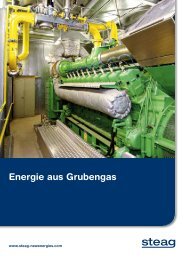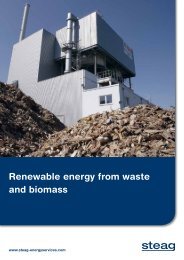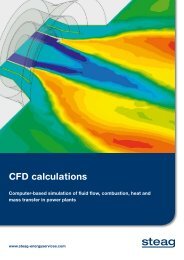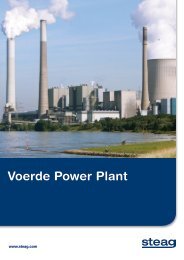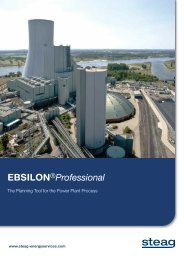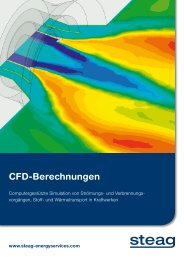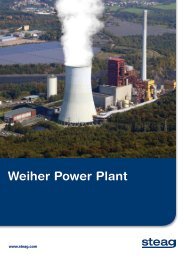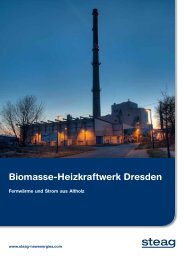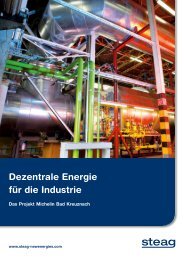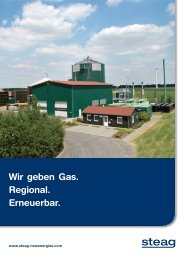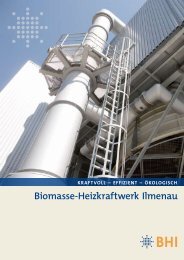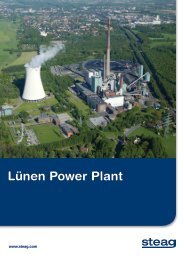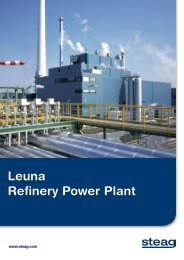Fenne Power Plant - STEAG
Fenne Power Plant - STEAG
Fenne Power Plant - STEAG
Create successful ePaper yourself
Turn your PDF publications into a flip-book with our unique Google optimized e-Paper software.
<strong>Fenne</strong> <strong>Power</strong> <strong>Plant</strong>www.steag.com
<strong>Power</strong> and heat for the futureThe <strong>Fenne</strong> power plant siteAs fifth biggest electricity producer in Germany, with ultramodernpower plants in and outside Germany and a variety ofservices, <strong>STEAG</strong> GmbH safeguards the energy supply of thefuture – reliably, efficiently, and with low environmental impact.<strong>STEAG</strong> blazes the trail for the energy sources biomass,biogas, mine gas, geothermics, wind and solar thermics. Theengineers of <strong>STEAG</strong> Energy Services GmbH develop, buildand operate power plants all over the world and are expertsfor the modernization of existing plants and for made-tomeasureenergy supply which goes easy on the climate andat the same time is economical.<strong>Power</strong> plants at home and abroad<strong>STEAG</strong> operates eleven power plants at ten locations inGermany with an installed capacity of about 7,500 MW; nineof these plants use hard coal as primary energy source. Attwo sites, each of which integrates an industrial power plant,refinery by-products also are used to produce steam, compressedair and electricity. Most of the electricity from hardcoal is supplied to industrial and public utilities. The customersinclude RWE, EnBW and Deutsche Bahn, the GermanRailways. Where there is a demand for it, cogeneration –the simultaneous production of power and useful heat – ispracticed. This heat either is used for heating purposes oris purchased by industrial enterprises in the form of processheat for their production processes. Outside Germany, too,the company contributes to public power supply with threehard-coal-fired power plants, capacity about 1,700 MW, inTurkey, Colombia and the Philippines. The efficient powerplants of <strong>STEAG</strong> make an active contribution to a secureand sustainable supply of energy.At the <strong>Fenne</strong> site, close by Völklingen, <strong>STEAG</strong> operates fourplants: the Völklingen model power plant, the Völklingencogeneration plant, the <strong>Fenne</strong> I district heating station, anda mine-gas-fired engine plant.In all, around 1.7 billion kilowatt-hours (kWh) of electricity and683 million kWhth of district heating are generated each yearat the site. The electricity could supply the needs of about425,000 single-family households.The Völklingen model power plantThe Völklingen model power plant was planned and constructedin 1982 as a forward-pointing prototype for stateof-the-artpower plant technology. Three specific technicalfeatures of the power plant are considered milestones in thedevelopment of efficiency-optimized and environment-friendlypower plants, for example the discharge of the entirelywet-cleaned flue gases via the cooling tower. The modelpower plant‘s burners are designed as combined burners,meaning that pulverized coal can be blown into the furnacetogether with coal mine methane gas.The Völklingen cogeneration plantThe Völklingen cogeneration plant went into service in 1989.Along with hard coal it can fire mine gas and coke gas. Atfull load the plant consumes 90 tons of coal per hour togenerate 600 tons of steam. District heating is extractedfrom tapping points in the intermediate-pressure turbine. Inheat exchangers, the recirculation water of the Saar districtheating network is heated from 70 °C to 130 °C.The mine gas engine plantThe former boiler and turbine house of the <strong>Fenne</strong> I powerplant houses one of the biggest mine-gas-fired engine plantsof its kind. Combustible, explosive coal mine methane gas issupplied to the power plant through the mine gas network of<strong>STEAG</strong> New Energies GmbH. With sophisticated technology,110 kilometers of gas lines ensure made-to-measure logistics.The plant has 14 engines, each with a capacity of3 MW (electric and thermal).In addition, the model power plant has a separate gasturbine. It is operated to cover high load requirements anddelivers 35 MW of electrical energy.
The power plant processThe coal, which is delivered to <strong>Fenne</strong> by rail, goes from coalyard to power plant via an underground belt conveyor system.From there it is transported to the coal mills. The millspulverize the fuel, which is dried with hot air and then burnedin the furnace at temperatures of about 1,300 °C.During combustion, hot flue gas is formed. In kilometers oftubes in the steam generator, the flue gas heats water tomake steam. The steam, which reaches a temperature ofup to 530 °C and is under high pressure, is conducted intoa turbine where it impacts the turbine blades and causesthe turbine shaft to rotate. A connected generator produceselectricity from this motion, like a dynamo. Transformersbring the electricity up to the necessary voltage and feed itinto the grid.When the steam has finished its work in the turbine it isconducted into a condenser. This is a large heat exchangerwith many tubes in which cooling water circulates. Thesteam comes in contact with the tubes and forms droplets(condensation), much like humid air on a cold window pane.The condensed water droplets are collected and pumpedback into the boiler to complete the cycle. In the process thecooling water from the condenser heats up from about 20 °Cto 30 °C. It is piped into cooling towers where it cascadesdown and cools off again. A small portion evaporates and isreplaced by water from the Saar River.Combined heat and power from <strong>Fenne</strong>In addition to electricity, district heating is produced inWeiher. With an installed district heating capacity of about600 MW, the Völklingen-<strong>Fenne</strong> site forms the backbone ofthe Saar district heating network, which extends from Dillingento Saarbrücken and, with a length of 35 km, is one ofthe biggest regional interconnected district heating systemsin Germany.Protecting the environmentWhen coal is fired, flue gases form which contain mainlyparticles of ash, dust, nitrogen oxides and sulfur dioxide. Formany years <strong>STEAG</strong> has been using highly effective methodsto reduce the emissions of these substances. When a powerplant is built today, a third of the expenditure goes intoenvironmental protection, most of it into air pollution control.<strong>STEAG</strong> will make substantial investments in environmentalprotection in future too. The emissions of the power plantare continuously measured. The company‘s environmentalprotection officers monitor and evaluate the measurements.In addition they have independent bodies like the Germaninspecting authority TÜV make measurements.Natural-draft cooling tower with flue gas dischargeIn <strong>Fenne</strong>, the method of flue gas discharge via cooling toweris special. It was first practiced in the model power plant inthe1980s. The cleaned flue gases are conducted into thecooling tower, where they rise up into the atmosphere togetherwith the water vapor from the tower. For this reason,the cogeneration plant and the model power plant do notneed stacks. A further positive effect of this: after desulfurizationthe flue gases no longer have to be reheated toensure the required lift, as is the case when they are releasedthrough a stack. So no energy is lost.plant and the model power plant work on the principle ofair staging. In the immediate area of the flame, where it ishottest, only as much air as is necessary to burn the coal isavailable. As a result, only very little nitrogen burns to form nitrogenoxide. In two further stages, and at increasingly largerdistances from the hot flame, more air is supplied so that thepulverized coal can burn up completely. There lower temperaturesprevail, in which only very little nitrogen can oxidize.Valuable by-productsThe <strong>STEAG</strong> subsidiary <strong>STEAG</strong> <strong>Power</strong> Minerals GmbH isresponsible for recycling the by-products of all <strong>STEAG</strong> hardcoal-firedpower plants in Germany. <strong>Power</strong> plant by-productswhich originate in the firing process are valuable and aremarketed. The by-products include fly ash, boiler sand, slagtap granulate and FGD gypsum.These power plant by-products are environmentally soundand can be used in almost all applications as constructionmaterials without impairing the soil or groundwater. Treatmentis only necessary in special cases. In contrast to thenatural resources which are becoming increasingly scarce,power plant by-products will be available in the longer term,conserving natural raw materials.Schematic illustration of the power plant processFrom the viewpoint of physics, energy is not produced, but merely transformed. The energy is fixed to the coal in chemical form. The coal is burned in theboiler; the released heat heats up water. This gives rise to hot steam (thermal energy) which drives a turbine (mechanical energy). A connected generatorthen transforms this mechanical energy into electricity (electrical energy).The principle of low-NO xcombustionLow-NO xcombustion is a so-called in-furnace NO xreductionmeasure which ensures maximum environmental protectionalready during firing. The burners used in the cogeneration
Data and facts *Installed capacityUseful electricity outputDistrict heating (heating supplied)Annual coal consumption466 MW plus mine gas engine plant 42 MWabout 1.7 billion kWh / aabout 683 million. KWh th/ aabout 790,000 t / 620,000 tceModel power plantInstalled capacity230 MWSteam pressure190 barSteam temperature 530 °CCooling towerRecooling plant with wet natural-draft cross-flow cooling tower, height: 100 mWater vapor escaping from coolingabout 330 m 3 / htowerDust removalFlue gas desulfurization (FGD)NO xremoval (DeNO x)By-productsOperatorElectrostatic precipitatorLime slurry scrubbing, gypsum as final product tNon-catalytic SNCR plant directly in furnaceCoarse ash, fly ash, gypsum<strong>STEAG</strong> <strong>Power</strong> Saar GmbHOwners Modellkraftwerk Völklingen GmbH 70 % <strong>STEAG</strong> <strong>Power</strong> Saar GmbH30 % GDF Suez Energie Deutschland GmbHA site with a traditionCogeneration plantInstalled capacitySteam pressure236 MW190 barSteam temperature 530 °CCooling towerWater vapor escaping fromcooling towerDust removalFlue gas desulfurizationNO xremoval (DeNO x)By-productsOperatorOwnersRecooling plant with wet natural-draft counterflow cooling tower, height: 100 mabout 330 m 3 / hElectrostatic precipitatorLime slurry scrubbing, gypsum as final productHigh-dust DeNO xupstream of air heater and electrostatic precipitatorCoarse ash, fly ash, gypsum<strong>STEAG</strong> <strong>Power</strong> Saar GmbHKraftwerksgesellschaft Völklingen mbH & Co. KG<strong>Fenne</strong> has a long tradition as a power plant location. Constructionof a 60 MW power plant began as far back as 1923.The produced energy was only utilized to develop the coalmining industry on the Saar, however. In 1960, the plantknown as “<strong>Fenne</strong> I” got a further machine unit. In 1972, twonew gas- and oil-fired steam boilers for supplying industrialsteam were finally installed. Today they serve to ensure districtheating extraction from the power plant units.With the building of <strong>Fenne</strong> II in 1954, the first power plantwith a unit-type construction, with two times 72.5 MW electriccapacity, was erected. The <strong>Fenne</strong> III plant was commis-sioned in 1967. It needed only one boiler and a turbine toprovide an installed capacity of 163 MW and was the firstplant in <strong>Fenne</strong> to also produce electricity to be fed into thelocal power grid. It was shut down in 1996 and subsequentlytorn down.In 1982, the Völklingen model power plant went into operation.The cogeneration plant followed in 1989. Together withthe <strong>Fenne</strong> I district heating station and the mine gas engineplant, today they make up the Völklingen/<strong>Fenne</strong> power plantportfolio of <strong>STEAG</strong> <strong>Power</strong> Saar GmbH.Engine-based cogeneration plantModulesElectric capacityThermal capacityEngine generator block with 20-cylinder four-stroke spark-ignition engine as pre-chamber engine in lean fuel-airratio regime, 10 kV generator, heat exchanger for engine cooling water, lubricating oil and fuel mixture, gas supplyEngines 1–14: exhaust system with exhaust heat exchanger, muffler, and one stack flue eachSupply and exhaust air unit, sound booth, module controlTotal capacity of 14 modules: 42 MWTotal capacity of 14 modules: 42 MWFuel Mine gas, methane (CH 4) content 30 % to about 90 %OperatorOwner<strong>STEAG</strong> <strong>Power</strong> Saar GmbH<strong>STEAG</strong> New Energies GmbHInstalled capacity = gross maximum capacity under nominal conditions; tce = ton of coal equivalent (standard coal equivalent); a more detailed explanation can be found on the reverse of the loose leaf.* as at December 31, 2011
<strong>STEAG</strong> GmbHRüttenscheider Strasse 1–345128 EssenGermanyPhone +49 201 801-00Fax +49 201 801-6388Email info@steag.comwww.steag.com<strong>STEAG</strong> <strong>Power</strong> Saar GmbHTrierer Strasse 466111 SaarbrückenGermanyPhone +49 681 9494-05Fax +49 681 9494-2244Email info-powersaar@steag.comwww.steag-powersaar.com<strong>Fenne</strong> <strong>Power</strong> <strong>Plant</strong>Saarbrücker Strasse 135–13766333 VölklingenGermanyPhone +49 681 9494-8210Fax +49 681 9494-8231Email sekretariat.fenne@steag.comPS-UK, as at June 2012



